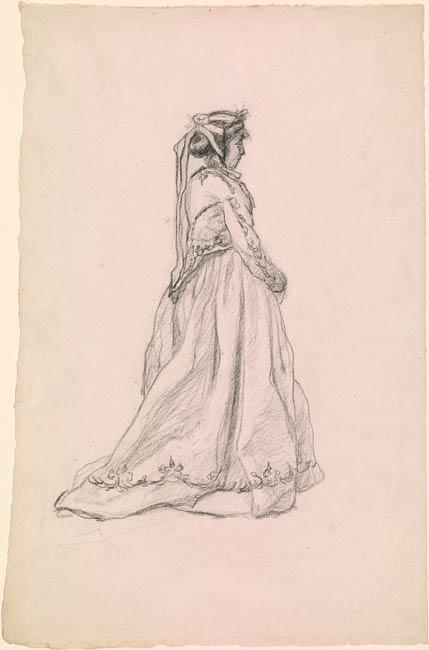
Tackling the same subject as Manet's famed canvas depicting a luncheon party outdoors-without the Renaissance-inspired combination of nude women and clothed men-the twenty-five-year-old Monet depicted a group of elegantly dressed figures picnicking in a garden in his vast, early picture Déjeuner sur l'herbe (Luncheon on the Grass). He began preparatory work for the canvas during the summer of 1865 while at Chailly-en-Bière, near Fontainebleau. However, he later abandoned the unfinished painting before the Salon of April 1866, in which he instead showed a full-length female portrait.
The painting survives only in two fragments--a vertical one depicting the three figures at left, and a square panel with the central seated group--both in the Musée d'Orsay, Paris. Fortunately, a small-scale version of the scene produced by Monet (begun in 1865, signed and dated 1866) and now in the Pushkin Museum of Fine Arts, Moscow, captures the entire composition, albeit in an earlier state than the final canvas. A preparatory oil study of the couple on the left is in the National Gallery of Art, Washington. Monet's fellow painter and close friend Frédéric Bazille and Camille Doncieux, who would later become Monet's wife modeled for this pair.
The enormous canvas presented Monet with the challenge of depicting life-size figures. This sheet documents the artist's exploration of the possibilities of drawing from the model as he embarked on his most ambitious painting to date, hoping to rival his predecessors and create a sensation at the Salon. Although he rarely made independent drawings, preferring to work directly on canvas, it is not surprising that he would have studied individual figures in preparation for a large painting that had to be executed in the studio. The model for the figure in the present study has been identified as Camille. However, Daniel Wildenstein (1991) suggests she may have been Eugénie or Gabrielle, models who frequently posed for Monet's female characters. With her face turned away, it is difficult to identify the sitter with any certainty.
In this delicate and carefully drawn study, Monet sought to fix the pose and contour of the woman's figure. The need to study the figure further in terms of pose, light, and color engendered the Washington oil study, in which Camille's body is turned further away, her head angled to the right. The pentimenti in the Washington oil sketch reveal that he strove to resolve the position of her right arm while painting. The folds of Camille's dress are different in the painted sketch and suggest that the drawing served as a starting point for the figure, which Monet further refined on canvas. In the final canvas, Camille's fashionable dress in the drawing and oil sketch was changed to a red one that was even more au courant. However, her costume in the reduced version of the scene in the Pushkin is the same as in the oil sketch and the present drawing.
The Morgan drawing is one of three surviving studies for the painting, along with a loosely drawn sketchbook sheet with an initial idea for the composition (Musée Marmottan, Paris) and a later black chalk study on blue paper of the scene (National Gallery of Art, Washington). The latter, along with the present sheet, remained with Bazille's family until being discovered in 1947 by Gabriel Sarraute. He first published the Thaw sheet as a study related to Femmes au Jardin, 1866-67 (Woman in the Garden; Musée d'Orsay, Paris), which Monet began after abandoning the Dejeuner and which Bazille purchased when the Salon rejected it. Camille's bonnet and pose in the drawing are close to those of the figure in Femmes au Jardin. That the drawing contains details corresponding with both the Dejeuner and Femmes suggests that Monet made the study in 1865 and returned to it shortly after that when he began work on the latter canvas.
Watermark: partial letter "M".
Thaw, Eugene Victor, former owner.
Thaw, Clare, former owner.
The Morgan Library & Museum, New York, NY, "Drawn to Greatness: Master Drawings from the Thaw Collection", 2017. Exh. cat., no. 269, repr.
The Thaw collection of master drawings : acquisitions since 2002. New York : Morgan Library & Museum, 2009, no. 43, repr.
Wildenstein, Daniel. Claude Monet : Biographie Et Catalogue Raisonné / Daniel Wildenstein. Lausanne ; Paris: La Bibliothèque Des Arts, 1974, vol. 1, p. 144, under no. 61; 1991, vol. 5, p. 124, no. D424 (erroneous inclusion of Mr. and Mrs. Paul Mellon in provenance).
